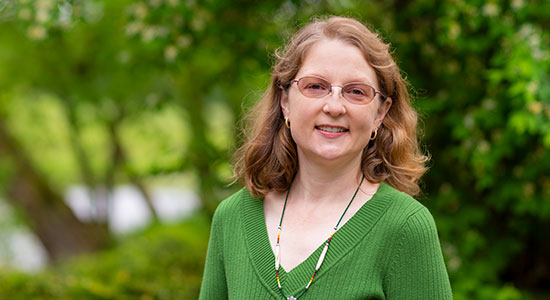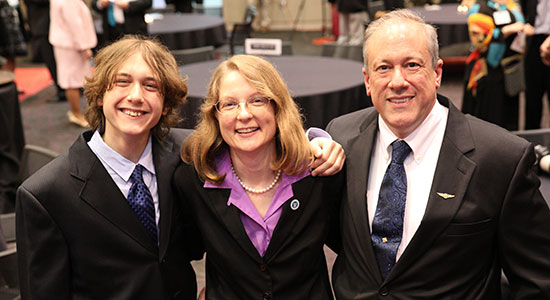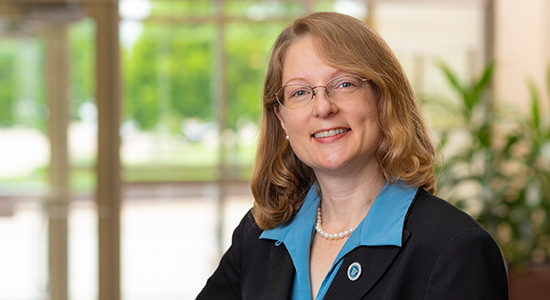
For Jill Kastner, family time often means hiking and other outdoor activities. “We love the outdoors, whenever we have time, and the weather cooperates.” Photo: Andy Mannis
After starting her career in BigLaw, Jill Kastner about a decade ago changed gears to join Legal Action of Wisconsin, where she now runs the Supportive Services for Veterans Program in the Milwaukee office. Her State Bar of Wisconsin involvement began in the Young Lawyers Division (YLD), where she served as president, and then continued to the Board of Governors and the leadership track to State Bar president.
“Running for president all came from complaining that it had been a good number of years since there had been a woman president, or even one who ran as a candidate,” Kastner says, noting that the last woman president was Diane Diel, in 2008-09. “I’m a firm believer that if you complain about the cooking, you’re now the new cook. When I got asked to run, it was time to put up or shut up.”
Early Life
A native of Cedar Grove, near Sheboygan, Kastner grew up in a blue-collar family and attended the University of Wisconsin-Oshkosh as an undergraduate and then UCLA for law school. Kastner’s parents did not attend college themselves but were determined to send all of their children, she says, although “I’m still the only lawyer in the extended family.”
Kastner did not think seriously about law as a career until she met a campus attorney in Oshkosh while working in the student government office. “I got to know him and hear about what he did, and how he was able to help students with landlord-tenant problems, consumer and debt problems, insurance issues,” she says. “He was a jack-of-all-trades, and an excellent resource for young kids from blue-collar families who didn’t know how to deal with some of these bigger life issues.”
Before then, she adds, “I didn’t know anything about the law other than what I saw on TV. I didn’t know if I wanted to be Matlock or one of the L.A. Law lawyers. Then I met this guy, and that’s when I realized that lawyers are problem solvers, and I wanted to do that. Thankfully, he was willing to explain to me what I needed to do to make that happen.”
Early Career
After finishing law school, Kastner started in the Orange County, Calif., office of McDermott, Will & Emery, then transferred to the Silicon Valley office to do intellectual property law. She moved back to Wisconsin after marrying a Wisconsin native, having her two children, and wanting to be closer to family. She went to work for Reinhart Boerner Van Deuren in Milwaukee, where she handled some intellectual property but also a broader array of work in areas including actuarial, product liability, and other litigation.
At that same time, Kastner undertook a variety of pro bono work on the side, which ultimately lured her in the direction of public interest law. “I took advantage [of pro bono opportunities] to get the [broader] experience and fulfill my commitment as an attorney,” she says. “I found myself enjoying that more than intellectual property or other big-business litigation. McDermott and Reinhart were wonderful places where I worked with wonderful people, but it was not as rewarding as the pro bono work I was doing at the time.”
Kastner then decided to “further cut my salary to go to Legal Action,” partly because the work sounded similarly rewarding, and partly because she had two young children, had paid off her student loans, and had a house and a car. “I was in a financial position where I could make that change, so I could spend more time with my kids,” she says.

Jill Kastner’s son Jacob and husband JP attended the swearing-in ceremony held at the State Bar’s Annual Meeting & Convention in Green Bay in June. She took office July 1. Photo: Shannon Green
Road to Opportunity
Kastner first worked at Legal Action in 2009 as a staff attorney with the Road to Opportunity program, where she helped clients handle matters such as expunging criminal records, removing barriers to employment, getting driver’s licenses, and structuring child support payments in a way that did not make them prohibitive.
Then in 2013, Kastner changed positions within Legal Action to the “fabulous program helping homeless and disabled veterans,” she says. “Primarily, I’m ensuring housing stability. Our goal is to end veteran homelessness. The way to do that is to remove barriers to sustainable housing.” That can include handling matters such as Social Security Disability Insurance claims, driver’s license recovery, eviction, child support, and unemployment claims. “I’m a jack-of-all-trades when it comes to civil poverty law,” she adds.
And Kastner is very fulfilled by her work. “It is incredibly rewarding to serve those who have served our country, and to make a difference in people’s lives,” she says. “When you prevent somebody from being evicted, get them Social Security disability, get their driver’s license back, it’s a big change. A lot of veterans come to me at a low point in their life. They see obstacles and hurdles, and they don’t know where to start.”
“An attorney can help them sort through what to change today, and what to change later, and what probably can’t be changed,” Kastner says. “Then we develop a step-by-step plan: What do we have to do today, next week, next month, so it doesn’t look so overwhelming. I’ve had clients for a year or two, or sometimes three as we go through the process. It’s about showing them that there is a light at the end of the tunnel.”
Quietly Forceful
David Pifer, the managing attorney at Legal Action who hired Kastner, said he could tell she was bright, skilled, and talented, even if she didn’t necessarily know the area of law thoroughly at the time. “I’ve never been disappointed,” he says. “She’s quiet and reserved – and someone you tangle with at your peril. Her demeanor belies an incredibly strong set of advocacy skills.”
Kastner has handled substantial complex litigation for Legal Action, including one case that she won before the Wisconsin Supreme Court. “She has this very quiet demeanor, but is persistent, she knows the information she needs to convey, she stays on point, and she obviously convinced the supreme court that they should decide in our favor,” Pifer says. “She’s just plain tenacious. On top of that, she’s a very good writer. And she’s one of the most efficient lawyers I’ve ever met. She can handle a volume of work that a lot of other people can’t handle, and a breadth of work that a lot of other people can’t handle.”
Jim Gramling, a retired judge and a pro bono advocate with the Center for Driver’s License Recovery & Employability, says he’s partnered with Kastner to assist a few clients, as well as to advocate for continued federal funding for legal aid work.
“She is an excellent attorney,” Gramling says. “She works to understand the legal issue and the client she’s serving. And then she has been very forceful in advocating for their rights. You have to very pointedly make their case for them.” Noting that Kastner comes from “a family of roofers,” he adds, “She obviously didn’t choose to follow the family tradition, but in her career work, she’s certainly served the purpose of keeping a roof over people’s heads.”
Kastner’s diversity of background will serve her well as State Bar president, says Jessica King, a college friend who is assistant vice president of clinical trials and process improvement for a patient advocacy firm, RSource, based in Boca Raton, Fla., which fights for payment of initially denied health insurance claims. “There are definitely people who aspire to BigLaw, and people who aspire to public-interest law,” says King, who once served on the board of Legal Action. “Jill has served that spectrum of experiences as a lawyer. That will really help her as she deals with the diverse membership of the Bar.”

"We’re going to have to develop programming and work with our legislature, law schools, and a lot of different groups, so that we get more attorneys into our most rural counties."
Moving Into Leadership
Kastner’s involvement in State Bar leadership began when King, also a former Wisconsin state senator and a former president of the YLD, encouraged her to step forward. Kastner became YLD president several years later.
What sustained her involvement was the ability to make positive change. “If there was change that needed to be made, you needed to work within the system to get that change to come about,” Kastner says. “One example was the lack of leadership training. We noticed that as young lawyers. Rather than sit around and complain about it, we worked hard to get funding and support of the larger Bar and leadership at the time, to do the Young Lawyers Leadership Conference.” Now called the Young Lawyers Conference, the event continues to this day.
As a Board of Governors member and later chair, Kastner also focused on leadership training, in particular the concept of bringing in more young lawyers of diverse backgrounds to become State Bar leaders – diverse in the sense of race and gender but also geography, practice areas, and types of employers. She and others developed an annual summit that has continued for six years. “Through that program, we’ve introduced a lot of very capable young lawyer-leaders,” she says. “They’ve taken on important leadership roles.”
It is incredibly rewarding to serve those who have served our country, and to make a difference in people’s lives.
Sherry Coley, a partner at Davis & Kuelthau, Green Bay, who first knew Kastner in the YLD, credits Kastner’s vision and determination in launching the leadership conference, along with Jim Boll, then-president of the State Bar, who provided discretionary funding for it. Coley succeeded Kastner as YLD president somewhat unexpectedly when Kastner’s about-to-be successor moved to Seattle.
“She called me up and said, ‘Sherry, I need you to fill this spot,’” Coley recalls. “She was past president when I was president. We worked very well together throughout that whole process.”
While working together in the YLD, King saw Kastner’s commitment to the profession through her thoughtful work on the leadership conference. “Newly admitted lawyers don’t have a lot of time,” King says. “They need to make sure the enrichment opportunities they choose to pursue add value. She made the effort to reach people who were practicing in rural and urban communities. She wasn’t just focused on ‘one-size-fits-nobody.’ She was trying to make sure the curriculum was valuable for a diverse set of lawyers.”
King says Kastner also did much through the division to advance the cause of the Wills for Heroes program, through which police officers, firefighters, and emergency medical technicians, both professionals and volunteers, and their spouses or domestic partners, can get their estate documents prepared.
“They’re placing themselves in harm’s way, for the greater good, but they might be of modest means and aren’t able to get those documents prepared,” King says. “Jill put in a lot of hours on that. That’s the kind of person you need. Jill put in a lot of elbow grease. It was a good effort and a good cause, to make sure their families have security. They’re not always compensated for the risks they’re taking.”
Priorities as President
After spending the past decade as a public-interest advocate for low-income people, homeless individuals, and veterans, perhaps it’s not surprising that Kastner identifies access to justice as a top State Bar priority. She believes that access should encompass everything from advocating for private bar public defender rates, “which hopefully the state is going to do for us,” to boosting legal aid, to attracting more lawyers to rural areas.
“Right now, there are a whole lot of counties with incredibly few attorneys, and no attorneys under the age of 55,” Kastner says. “That’s a problem today, and it’s going to be an even bigger problem in 10 years unless we address it. We need to find a way to attract younger lawyers – not necessarily twentysomethings – but young lawyers with families to realize there are great opportunities in those northern counties.
“We’re going to have to develop programming and work with our legislature, law schools, and a lot of different groups, so that we get more attorneys into our most rural counties,” she says.
Access to justice also includes the set of issues closer to home for Kastner. “I see that in my day-to-day job – there are veterans, the elderly, the disabled, crime victims – a lot of people who need legal representation but can’t afford it,” she says. “Unfortunately, legal aid does great work but there are not enough funds to meet the challenges. And that’s a problem. That means a lot of people aren’t getting the justice they deserve.”
It’s not just about getting things done. It’s about, are we doing things the right way? Are we doing this for the betterment of other lawyers, so they can succeed?
Kastner plans to continue the State Bar’s work on leadership development, in part by encouraging evolution of programs like the summit that she helped to create. “We’ve undergone a generation shift – we went from training younger generation X to the beginning of the millennials,” she says. “They’re going to outnumber the boomers very quickly. As we transition, it’s going to be important that we have millennial leaders who are ready to step in.”
For example, after chairing the summit the first couple of years, Kastner passed along that baton. “The measure of any true leader is, have you trained your replacements?” she says. “It’s important to pass that mantle onto someone else, particularly someone younger and more in tune with the folks who need the training.”
Kastner also plans to advance the State Bar’s diversity and inclusion efforts, which she believes have picked up steam in the past five years or so thanks to “deliberate and intentional steps,” and among other achievements have resulted in women becoming a majority on the Board of Governors.
“Again, it’s about race, gender, and disability, but also broader diversity in regard to different geographic and practice areas,” she says. “Government lawyers don’t always feel they have a voice. Solos in rural counties feel the Bar doesn’t do enough for them. We need to make sure they understand the resources the Bar has available to them, and if there are services the Bar isn’t providing, ensure we provide those services.”
A Skilled Collaborator
Pifer expects many of the attributes that have enabled Kastner to succeed at Legal Action will serve her well as State Bar president. “Jill is a very skilled person in collaborating with other people, and in working through problems in a way that everybody feels heard,” he says. “She’s spent a lot of time in the inner workings of the State Bar, and understanding what people need and how to get things done. As a lawyer, her business is to get things done. She does it very, very well for our clients, and I have every expectation that she’s equally skilled in working for the Bar.”
 Ed Finkel is an Evanston-based freelance writer.
Ed Finkel is an Evanston-based freelance writer.
Gramling figures that Kastner’s background in legal aid should help her advance the Bar’s efforts in areas like inclusion and access to justice. “She knows where the funding sources are, and who the players are,” he says. “That’s going to give her a head start in improving the way in which the bar association brings access to low-income people.”
Coley says Kastner will bring the right combination of toughness and compassion to the State Bar. “That combination of strengths is perfect for the organization,” she says. “It takes being tough, and pursuing a vision, in order to get some things done. But you’ve got to have that compassion piece. It’s not just about getting things done. It’s about, are we doing things the right way? Are we doing this for the betterment of other lawyers, so they can succeed? She has figured out that balance, and she will bring it to the State Bar.”
The lack of women leaders in the State Bar also has been on Coley’s mind. “Having a woman leader at this time is exactly what our organization needs,” she says. “I’m excited, and I’m grateful she is willing to serve. It’s a tough gig. She is still in that part of life when you’re managing a career, and raising a family with a spouse. Now you add a whole other career on top of that. But she has said, more than one time, ‘I will sleep when I’m dead.’”
Now, with the election of Kathleen Brost as president-elect, the State Bar for the first time ever will be led back-to-back by women presidents.
Chris Rogers, who stepped aside from president to past president as Kastner took the helm, has known her for many years through committees and the Board of Governors, and he has gained tremendous confidence in her abilities and her knowledge of the State Bar’s inner workings.
“She’s really got a handle on Bar operations and is really stellar at understanding how all the pieces fit together, and the history of all the different sections and divisions, and the policy decisions that the Bar has made over the past 10 years,” says Rogers, a shareholder with Habush, Habush & Rottier in Madison. “I don’t know of a stronger person in that regard. That foundation is going to serve her well and serve us well.”
Kastner brings a number of other positive qualities to the table, Rogers says. “She’s personable and well respected,” he says. “She’s easily accessible, and she does a very good job of getting the point she needs to come across. Because she’s been involved in so many aspects of the Bar, she’s well respected across many committee lines. And she’s a tireless advocate for diversity, which is something that is and rightly should be a main focal point for the Bar.”
King sees Kastner as the classic servant-leader. “Jill has this ability to set a vision, as a leader, and the ability to roll up her sleeves and work alongside others of like mind to complete a project,” she says. “She leads by example. She’s not going to ask others to do a project she wouldn’t do herself. That’s going to go a long way.”
In her higher profile role, Kastner is serving as an even brighter role model for younger lawyers, King says. “She gives people an opportunity to see a professional woman, mother, lawyer, and volunteer, all in the same package,” she says. “She’s so genuine in her pursuits. The things she’s choosing to focus on for the Bar will advance under her stewardship. When she talks about diversity and inclusion, access to justice, leadership, those are things she’s spent years working on as an average Bar member. She knows the amount of time that goes into those projects.”
Personal Life
Beyond work and the State Bar, Kastner, a resident of suburban Glendale, also has been active in her community, organizing the annual Independence Day parade, serving as Sunday school teacher and an elder at the North Shore Presbyterian church, and volunteering for other events.
Family time often means hiking and other outdoor activities with her husband of 20 years, JP, daughter Julia, 17, and son Jacob, 14. Kastner has completed more than 400 miles of the Ice Age Trail. “We love hiking the Ice Age Trail,” she says. “We love the outdoors, whenever we have time, and the weather cooperates.”
For all the State Bar’s many priorities to serve members and our justice system, Kastner says there is too much work for any one person. That is why she says her year as president is not about her. It is about State Bar members themselves and the hundreds of volunteers who work to advance the organization’s goals.
